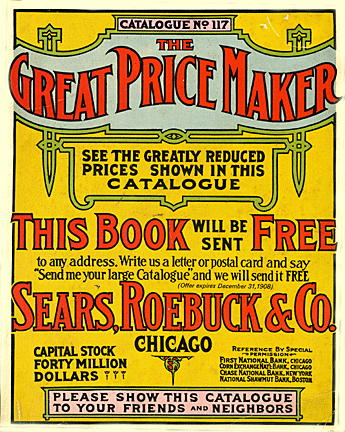 Before
there was Amazon.com, there was the Sears Catalogue. It was
the “Great “Price Maker” that served as a mirror of its time,
recording for future historians people’s habits, customs, desires,
and modes of living. The roots of the Sears Catalogue are as old as
the company.
Before
there was Amazon.com, there was the Sears Catalogue. It was
the “Great “Price Maker” that served as a mirror of its time,
recording for future historians people’s habits, customs, desires,
and modes of living. The roots of the Sears Catalogue are as old as
the company.
Richard W. Sears, a railroad station agent in Minneapolis,
Minnesota, founded the R.W. Sears Watch Company in 1886 to sell
watches by mail order at $14 each. He relocated his business to
Dearborn and Randolph Streets in Chicago in 1887, hired Alvah C.
Roebuck to repair watches, and established a mail-order business for
watches and jewelry. The company offered its first Catalogue the
same year.
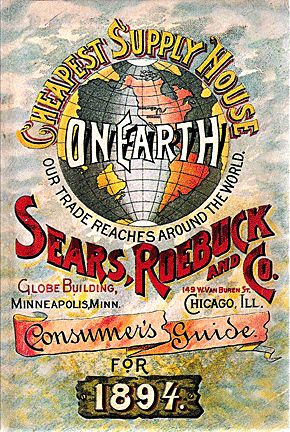 The
time was right for mail order merchandise. Fueled by the Homestead
Act of 1862, America’s westward expansion followed the growth of the
railroads. The postal system aided the mail order business by
permitting the classification of mail order publications as aids in
the dissemination of knowledge entitling these Catalogues the
postage rate of one cent per pound.
The
time was right for mail order merchandise. Fueled by the Homestead
Act of 1862, America’s westward expansion followed the growth of the
railroads. The postal system aided the mail order business by
permitting the classification of mail order publications as aids in
the dissemination of knowledge entitling these Catalogues the
postage rate of one cent per pound.
In 1889 Sears sold his business, and a few years later founded, with
Roebuck, another mail-order operation, which in 1893 came to be
known as Sears, Roebuck and Company.
All this set the stage for the Sears, Roebuck and Company Catalogue.
A master at slogans and catchy phrases, Richard Sears illustrated
the cover of his 322-page 1894 Catalogue declaring it the "Book of
Bargains: A Money Saver for Everyone," and the "Cheapest Supply
House on Earth," claiming that "Our trade reaches around the World."
Sears also knew the importance of keeping customers, boldly stating
that "We Can’t Afford to Lose a Customer." He proudly included
testimonials from satisfied customers and made every effort to
assure the reader that Sears had the lowest prices and best values.
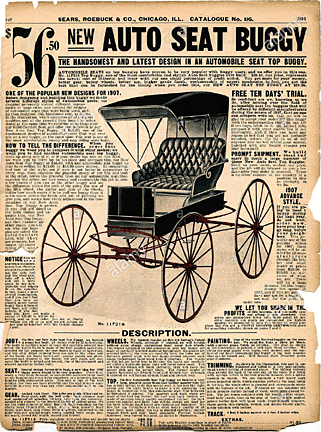 This
Catalogue expanded from watches and jewelry, offering a
mind-boggling merchandise such as sewing machines, sporting goods,
musical instruments, saddles, firearms, buggies, bicycles, baby
carriages, and men’s and children’s clothing. The 1895 Catalogue
added eyeglasses, including a self-test for "old sight, near sight
and astigmatism." At this time Sears wrote nearly every line
appearing in the Catalogues drawing upon his personal experience
using language and expressions that appealed to his target
customers.
This
Catalogue expanded from watches and jewelry, offering a
mind-boggling merchandise such as sewing machines, sporting goods,
musical instruments, saddles, firearms, buggies, bicycles, baby
carriages, and men’s and children’s clothing. The 1895 Catalogue
added eyeglasses, including a self-test for "old sight, near sight
and astigmatism." At this time Sears wrote nearly every line
appearing in the Catalogues drawing upon his personal experience
using language and expressions that appealed to his target
customers.
In 1895 Julius Rosenwald, a wealthy clothing manufacturer, bought
out Roebuck’s interest and reorganized the mail-order business.
Sears meanwhile wrote the company’s soon-to-be-famous Catalogues.
The company grew tremendously by selling a range of merchandise at
low prices to farms and villages that had no access to retail
stores. The initiation of rural free delivery in 1896 and of parcel
post in 1913 by the U.S. Postal Service enabled Sears to
economically send its merchandise to even the most isolated
customers.
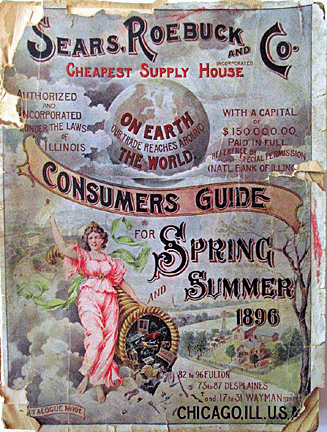 In
1896 Richard Sears added a spring and fall Catalogue and enlarged
its size. He also extended an open invitation for all customers to
visit the company’s Chicago headquarters. For the first time the
company charged for the Catalogue. Sears tried to mitigate the
25-cent fee by promising to apply the fee to any orders over 10
dollars. Specialty Catalogues now appeared covering such items as
bicycles, books, clothing, groceries, pianos and organs, and sewing
machines. Sears sold the earliest entertainment centers in the form
of magic lanterns. These were either a single slide type, or a
version called the chromatrope, which showed a succession of slides
giving the viewers a motion picture feel.
In
1896 Richard Sears added a spring and fall Catalogue and enlarged
its size. He also extended an open invitation for all customers to
visit the company’s Chicago headquarters. For the first time the
company charged for the Catalogue. Sears tried to mitigate the
25-cent fee by promising to apply the fee to any orders over 10
dollars. Specialty Catalogues now appeared covering such items as
bicycles, books, clothing, groceries, pianos and organs, and sewing
machines. Sears sold the earliest entertainment centers in the form
of magic lanterns. These were either a single slide type, or a
version called the chromatrope, which showed a succession of slides
giving the viewers a motion picture feel.
Sears added a color section in 1897, advertising shoes in black, red
and brown. New products included cloth bound books as cheap
alternatives to hardbound books, and the Edison Graphophone Talking
Machine. Incorporating a new
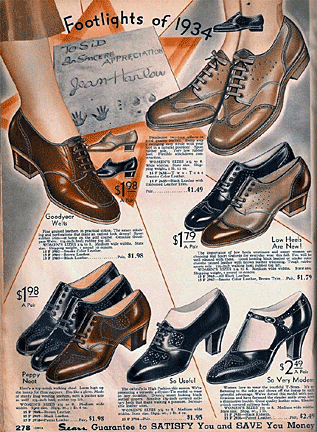 trend,
Sears added a "club order program" encouraging customers to combine
their orders with friends or neighbors to share in discounts. A
Builders Hardware and Material Section selling everything a customer
needed to construct a building, soon appeared. Noting that all men
are not equal in size and shape, Sears targeted the extra stout and
extra large customer with men’s laundered shirts specifically made
for them.
trend,
Sears added a "club order program" encouraging customers to combine
their orders with friends or neighbors to share in discounts. A
Builders Hardware and Material Section selling everything a customer
needed to construct a building, soon appeared. Noting that all men
are not equal in size and shape, Sears targeted the extra stout and
extra large customer with men’s laundered shirts specifically made
for them.
In 1898, he added more specialty catalogues including ones for
photographic goods, talking machines, and mixed paints. In the
general Catalogue a color section showed different buggies in red,
green, brown, and black with gold or silver trim. He placed the
Graphophone in an office setting, and the optigraph moving picture
machine appeared. Reflecting current events, the lantern slide
collection included shows on the Klondike gold fields, the
destruction of the Maine and the Cuban war.
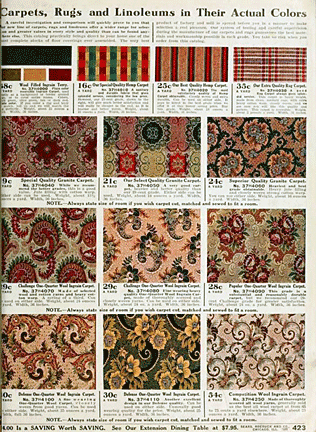 The
1899 Catalogue featured color images of carpets, furniture, and
china. In the photographic supplies section Sears offered "Special
Lecture Outfits" giving the purchaser projection equipment, a
screen, advertising posters, admission tickets, and a printing
outfit, everything an entrepreneur needed to set up a theater for
paying customers. The optigraph moving picture equipment worked with
either electricity or a system using a gas process to provide
illumination. Limes were one of the ingredients used in these gas
systems helping coin the phrase "in the lime light."
The
1899 Catalogue featured color images of carpets, furniture, and
china. In the photographic supplies section Sears offered "Special
Lecture Outfits" giving the purchaser projection equipment, a
screen, advertising posters, admission tickets, and a printing
outfit, everything an entrepreneur needed to set up a theater for
paying customers. The optigraph moving picture equipment worked with
either electricity or a system using a gas process to provide
illumination. Limes were one of the ingredients used in these gas
systems helping coin the phrase "in the lime light."
The 1903 Catalogue included the commitment "Your money back if you
are not satisfied," and Richard Sears added a handwritten note to
his customers. Always looking to cater to customer needs, Sears
employed translators who could "read and write all languages." He
featured new items such as barber chairs, disc graphophones, and
basketballs and goals (hoops). The next year he sold the Eveready
searchlight and the babygate, and the company announced the opening
of the Sears camera factory. The wig department added wigs for
African-American men and women. To encourage repeat customers, Sears
initiated a program called "customer profit sharing" giving the
customer a one-dollar certificate for every dollar spent. By
accumulating these certificates the customer could redeem them for
specific items.
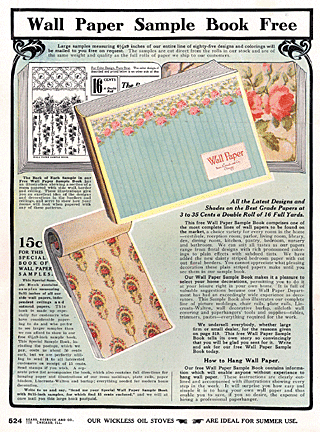 To
get a hands on feel, the 1905 Catalogue featured full color and
texture wallpaper samples, and a swatch of material used in men’s
suits. Following this trend, the next year he added paint samples,
and in 1908, the last year Richard Sears was associated with the
company, he offered both wallpaper and paint color sample books to
customers.
To
get a hands on feel, the 1905 Catalogue featured full color and
texture wallpaper samples, and a swatch of material used in men’s
suits. Following this trend, the next year he added paint samples,
and in 1908, the last year Richard Sears was associated with the
company, he offered both wallpaper and paint color sample books to
customers.
Sears’ simple, warm and customer-service-centered approach helped it
stand out among mail-order competitors like Montgomery Ward and
Hammacher Schlemmer. When Sears first sold stock to the public in
1906, the company was worth some $40 million, with close to $50
million in annual sales and around 9,000 employees. That same year,
it built a distribution complex in Chicago with some 3 million
square feet of floor space.
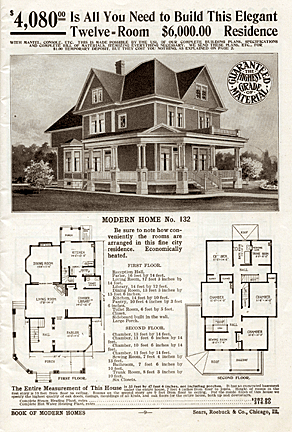 Among
the catalog giant’s astounding range of offerings were house kits,
which the company began marking in 1908. The kits came in 447
different designs, from the grand “Magnolia,” which sold in the
$5,000 range, to the humble and popular “Winona,” selling for $750
to just under $2,000. Sears advertised the kits with the promise
that “We will furnish all the material to build this house. All the
parts arrived precut and ready to assemble.
Among
the catalog giant’s astounding range of offerings were house kits,
which the company began marking in 1908. The kits came in 447
different designs, from the grand “Magnolia,” which sold in the
$5,000 range, to the humble and popular “Winona,” selling for $750
to just under $2,000. Sears advertised the kits with the promise
that “We will furnish all the material to build this house. All the
parts arrived precut and ready to assemble.
With the advent of the automobile, the mail-order boom slowed
somewhat, but Sears managed to stay successful by expanding consumer
credit with its “No Money Down” policy.
While traditional department stores, such as Marshall Field’s and
Wanamaker’s, sold higher-end fashion, Sears had made its reputation
selling less expensive but necessary items like socks, underwear,
towels and bedding, which helped keep sales going even during the
Great Depression.
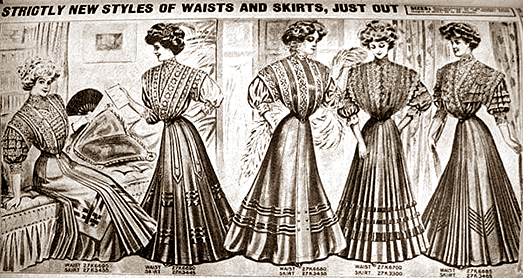
Sears issued its first Christmas Catalogue in 1933, featuring such
must-have items as a Mickey Mouse watch, a Lionel electric train
set, a “Miss Pigtails” doll and live singing canaries. In the
decades that followed, the Catalogue would be adorned with Christmas
scenes, even as its pages swelled. By 1968, when it was officially
renamed the “Wish Book,” the Catalogue boasted 225 pages of toys and
380 pages of gifts for adults, for a grand total of 605 pages.
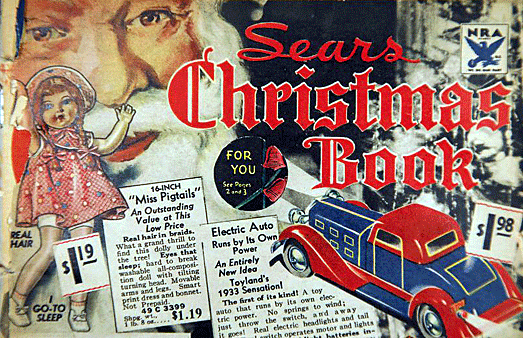
In 1993, Sears announced it was closing its catalog division,
bringing to an end a storied era of mail-order bargain-hunting and
wish fulfillment that had begun nearly a century earlier.
